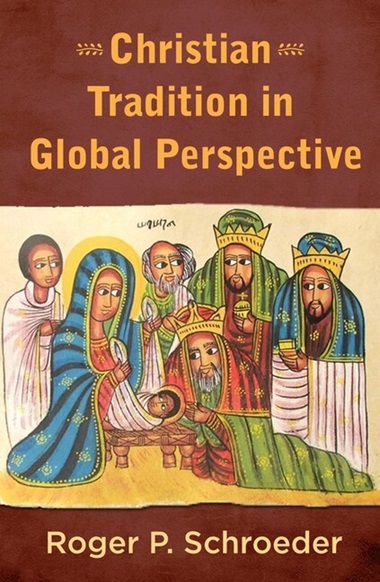 With Mission Fest coming up quickly (February 15 – 17 at Westside Church) I am posting a series on Christianity as a missionary religion:
With Mission Fest coming up quickly (February 15 – 17 at Westside Church) I am posting a series on Christianity as a missionary religion:
1. History of Missions
2. State of World Christianity
3. Specific Areas: Africa
4. Specific Areas: Asia
5. Specific Areas: Latin America
6. Not So Good News
7. New Approaches to Missions
I will look mainly at some of the new books covering these various areas, but will also try to cover a few key themes along the way. It probably goes without saying that I will just scratch the surface of each topic – but I do hope that people will go on to read some of the books, which are of high quality.
II. World Christianity
Everyone knows that Christianity is a world religion – the largest world religion in fact. And that is largely due to missionary activity.
But not all that initiative came from the West, as we tend to think. For the past 20 or so years, a new field of study has flourished – World Christianity (or Global Christianity) – which helps us to gain a new perspective on how God’s mission has been playing out worldwide.
We might think of Africa, where indigenous missionaries have been responsible for most of the explosive growth of the church over the past 100 years. Or China, where many in the West despaired of church’s future when missionaries were forced out by the communists – only to see it grow dynamically in the late 20th century.
Or India, where missionaries regularly travel from one part of that vast and diverse nation to another to witness. Not to mention the large missionary contingents now being sent out from Korea, Brazil, Nigeria and other nations.
But the phenomenon goes back much further. For example, Roger P. Schroeder in Christian Tradition in Local Perspective (Orbis Books, 2021) writes:

The Christian missionary Alopen and the Emperor Taizong, China; from the French School.
In the year 635 CE, Alopen and his small group of East Syrian Christian monks came to the end of their long journey across Asia and over the Silk Route. They arrived in Chang’an (present-day Xi’an), the first capital of the ancient Chinese Empire and the largest city in the world at that time. . . . This amazing story marks the beginning of the first era of Christianity in China, which lasted over 200 years.
Most Christians and students of church history are not familiar with this movement, which occurred before Boniface, the Apostle of Germany, was even born. Or that there were thriving Christian communities in present-day Iraq, Iran and India for several hundred years before Patrick stepped foot in Ireland.
The history of Christianity has normally been told and retold – whether in Vietnam, Germany, Chile or the United States – from a Eurocentric perspective. In fact, the ‘good news’ in the early centuries of the church spread more quickly north, south and east of Jerusalem rather than westward into Europe.
Only much later, in 1500, does Christianity for the first time in its history find itself in “a rather lopsided situation” whereby the “majority of the world’s Christians resided in the European West” (Irvin and Sunquist 2001, 504). That perception unfortunately continues to a great extent even though the majority of Christians since the end of the 20th century live – or were born – in Africa, Latin America, Asia or the Pacific. It is estimated that by 2025, two-thirds of Christians will be of the Global South (Jenkins 2002, 3).
Christian Tradition in Local Perspective, and a good number of other recent books, thus “attempt to recount the history of Christianity from a polycentric perspective.”
Recent books
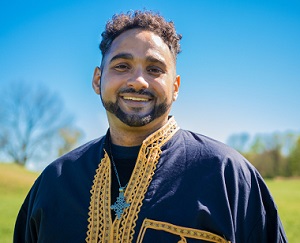
Vince Bantu says Christianity has always been a global religion.
Three scholars with local connections wrote these books:
- Vince L. Bantu: A Multitude of All Peoples: Engaging Ancient Christianity’s Global Identity (IVP Academic, 2020)
- Jehu J. Hanciles, editor: World Christianity: History, Methodologies, Horizons (Orbis Books, 2021)
- Brian Stanley: Christianity in the Twentieth Century: A World History (Princeton University Press, 2018)
Vince Bantu’s key theme is reflected in the name of his book, A Multitude of All Peoples (IVP Academic, 2020):
Many contemporary missiologists and church historians would have us believe that Christianity came into Africa and Asia from Europe when the reality is quite the opposite in several significant respects. Christianity is not becoming a global religion; it has always been a global religion. . . .
Despite the persisting association of the Christian faith with Western culture/whiteness, Christianity has always been a global religion that spread from Jerusalem in every direction.
Bantu, who teaches at Fuller Theological Seminary, was a visiting professor at Regent College last summer.
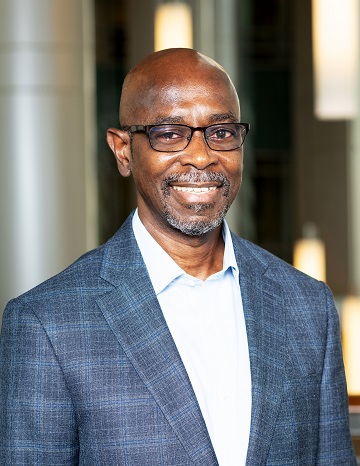
Jehu Hanciles says the field of World Christianity is flourishing.
Jehu Hanciles states in World Christianity, “Based on the most cursory assessment of the last decade or so, the field of world Christianity is flourishing.”
Drawing on some key players (Kirsteen Kim, Gina Zurlo, Dyron Daughrity, Emma Wild-Wood and others), he includes articles which interpret the growth and significance of World Christianity; its overlap with other disciplines; and ‘expanding horizons,’ featuring specific parts of the world.
The first contributor to the book, Dana L. Robert (Director of the Center for Global Christianity and Mission at Boston University School of Theology), writes:
Collaborative conversation among scholars and practitioners, many with firsthand experience in the global South, showed that the depressing tropes of inevitable secularization and Western denominational malaise were not the center of the story.
Western colonialist oppression, while important to face and reject, was not what defined Christian identity worldwide.
Rather than mission history being a tale of expanding empire with outposts run by colonial-era missionaries, it became clear that the margins and the center were always shifting. The local and the global constantly intersected. The seemingly powerless used their faith to create new identities.
The founding of indigenous churches, the spread of liberation theologies, the global flow of Pentecostal worship – all these were signs of vitality, not a death spiral of the Christian faith. World Christianity was not the story of Western denominations and institutions bound by rigid doctrine generated by powerful gatekeepers.
Rather, as a ‘social organism,’ it included women and children who worshiped under trees in Africa, migrant preachers who traversed urban spaces across the Americas, Catholic sisters who led base Christian communities, Asian religious minorities who pushed for social change, eastern Europeans who brought down the Iron Curtain, and globe-trotting pilgrims from everywhere to everywhere.
Hanciles, Director of the World Christianity program at Chandler School of Theology, was to have taught at Vancouver School of Theology last summer, though I believe he was not able to make it in the end.
 Brian Stanley (who edited Andrew Walls’ The Missionary Movement from the West, which I featured last week), states in his own Christianity and the Twentieth Century that Western historians of Christianity have tended to neglect the 20th century in favour of the 19th. He adds :
Brian Stanley (who edited Andrew Walls’ The Missionary Movement from the West, which I featured last week), states in his own Christianity and the Twentieth Century that Western historians of Christianity have tended to neglect the 20th century in favour of the 19th. He adds :
Yet it was the twentieth century that shaped the contours of the Christian faith as it is now, a culturally plural and geographically polycentric religion clustered around a number of new metropolitan loci in the non-European world, from Seoul to São Paulo.
The majority of its rapidly growing number of adherents found the post-Enlightenment questions that preoccupied the churches of the North and West to be remote from their pressing everyday concerns of life and death, sickness and healing, justice and poverty.
In Islamic regions of Africa and almost all of Asia they were also intimately concerned with the implications of living as religious minorities in a context dominated by the majority religious tradition . . . Their theological priorities and ethical perspectives differed accordingly from those of Christians in the North.
The twentieth century thus set the agenda for the theological and ethical issues that now constitute the fault lines dividing Christians and churches from each other – fault lines that are significantly different from those inherited from the European religious past and that still determined the denominational geography of Christianity in 1900.
Stanley delivered a lecture at Regent College in the fall of 2022. Alex Strohschein, a Regent College graduate, wrote a review of Christianity in the Twentieth Century.
Alexander Chow, Senior Lecturer in Theology and World Christianity in the School of Divinity, University of Edinburgh, Co-director of the Centre for the Study of World Christianity and author of Chinese Public Theology (Oxford University Press, 2018) also taught at Regent College last summer.
- David R. Swartz: Facing West: American Evangelicals in an Age of World Christianity (Oxford University Press, 2020)
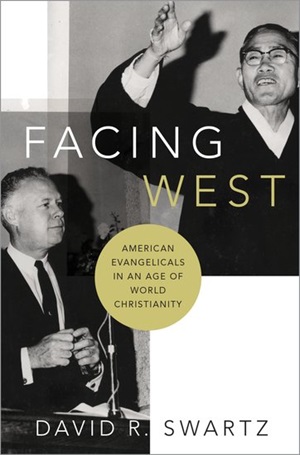 Veteran historian George Marsden describes Facing West as “a fascinating and important book that can help reorient perspectives of American evangelicals.” And Canadians – sure, we’re different, but we also have plenty in common – and we still need to take note of the outsize influence of American culture worldwide.
Veteran historian George Marsden describes Facing West as “a fascinating and important book that can help reorient perspectives of American evangelicals.” And Canadians – sure, we’re different, but we also have plenty in common – and we still need to take note of the outsize influence of American culture worldwide.
The OUP description of the book is useful:
In 1974 nearly 3,000 evangelicals from 150 nations met at the Lausanne Congress on World Evangelization. Amidst this cosmopolitan setting – and in front of the most important white evangelical leaders of the United States – members of the Latin American Theological Fraternity spoke out against the American Church.
Fiery speeches by Ecuadorian René Padilla and Peruvian Samuel Escobar revealed a global weariness with what they described as an American style of coldly efficient mission wedded to a myopic, right-leaning politics. Their bold critiques electrified Christians from around the world.
The dramatic growth of Christianity around the world in the last century has shifted the balance of power within the faith away from traditional strongholds in Europe and the United States. To be sure, evangelical populists who voted for Donald Trump have resisted certain global pressures, and Western missionaries have carried Christian Americanism abroad.
But the line of influence has also run the other way. David R. Swartz demonstrates that evangelicals in the Global South spoke back to American evangelicals on matters of race, imperialism, theology, sexuality and social justice. From the left, they pushed for racial egalitarianism, ecumenism and more substantial development efforts. From the right, they advocated for a conservative sexual ethic grounded in postcolonial logic.
As Christian immigration to the United States burgeoned in the wake of the Immigration Act of 1965, global evangelicals forced many American Christians to think more critically about their own assumptions.
The United States is just one node of a sprawling global network that includes Korea, India, Switzerland, the Philippines, Guatemala, Uganda and Thailand. Telling stories of resistance, accommodation and cooperation, Swartz shows that evangelical networks not only go out to, but also come from, the ends of the earth.
- David Lindenfeld: World Christianity and Indigenous Experience: A Global History, 1500 – 2000 (Cambridge University Press, 2021)
 David Lindenfeld surveys indigenous experiences with Christianity all over the world; his “cross-cultural reflections provide a compelling alternative to the Western narrative of progressive development.” But World Christianity and Indigenous Experience does not ‘take sides or provide simple answers.”
David Lindenfeld surveys indigenous experiences with Christianity all over the world; his “cross-cultural reflections provide a compelling alternative to the Western narrative of progressive development.” But World Christianity and Indigenous Experience does not ‘take sides or provide simple answers.”
For example, he says early on:
Before proceeding, however, it should be pointed out that there already is, ready-at-hand, a broad interpretive framework – which could be characterized as a grand narrative – to account for missionary encounters with non-Western peoples. This is the view that missionaries have been agents of Western cultural imperialism, imposing their values and practices on others in all corners of the globe.
Referring to compelling anti-missionary narratives in novels such as James Michener’s Hawaii and Barbara Kingsolver’s The Poisonwood Bible, he responds:
Although this narrative contains some truth, it has increasingly come to be an overly simplistic take.
One can point to at least as many counterexamples of missionaries’ extraordinary self-sacrifice, heroism and kindness, which surely made a positive impression on indigenes. To be sure, one finds many such stories in the hagiographical literature generated by the missionary movement itself, which was often written for the purpose of fundraising.
In fact, the historical sources provide abundant evidence for both stereotypes. Missionaries spent much time issuing prohibitions, telling people what they could not do or what they must give up, while at the same time providing services and assistance that were greatly beneficial, such as healing, tools, literacy and love.
He says this is “just one instance of the complexity and many-sidedness of the missionary-imperialism issue,” noting that there are sophisticated postcolonial versions which implicate missionaries in ‘cultural imperialism.’ He says his approach is to “[view] missionary encounters from indigenous points of view.”
And he is interested in the current situation, saying:
[An] intriguing challenge to world Christianity in the future is how it will deal with the phenomenon of indigenous cultural revival among peoples (eg, Native Americans, Australian Aborigines and Maori) who had been exposed to prolonged missionary activity. To what extent do such movements entail a rejection of Christianity? How adaptable is Christianity to such revivals of indigenous cultural expression?
 A very recent book by local pastor/scholar Aaron Ross deals with some of the issues raised. I posted a note about The Holy Spirit and the Eagle Feather: The struggle for Indigenous Pentecostalism in Canada (McGill-Queens University Press 2023) a few weeks ago.
A very recent book by local pastor/scholar Aaron Ross deals with some of the issues raised. I posted a note about The Holy Spirit and the Eagle Feather: The struggle for Indigenous Pentecostalism in Canada (McGill-Queens University Press 2023) a few weeks ago.
Part of it reads:
Drawing on interviews with contemporary figures in the movement, he describes how Indigenous Pentecostals would come to challenge the mission’s eurocentrism over decades, eventually entering positions of leadership in the church.
This process required them to confront the painful vestiges of colonialism and to grapple with the different philosophies and theologies of Pentecostalism and Indigenous traditional spiritualities. In doing so they indigenized the movement and forged a new identity, as Indigenous and Pentecostal.
The state of World Christianity
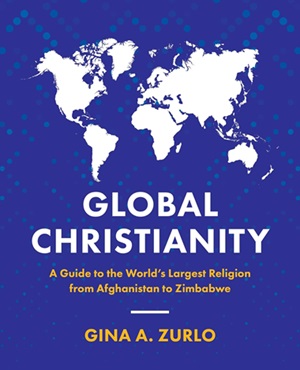 The books I’ve been referring to are fairly serious reads – not at all beyond pastors or anyone who reads regularly – but not light either.
The books I’ve been referring to are fairly serious reads – not at all beyond pastors or anyone who reads regularly – but not light either.
Another way to enter into the realm of World Christianity would be to look at an engaging new book. Gina Zurlo, working with researchers at the Center for the Study of Global Christianity, has written Global Christianity: A Guide to the World’s Largest Religion from Afghanistan to Zimbabwe (Zondervan, 2022).
Jon Hoglund wrote about the book for the Lausanne Movement. Here is a portion:
Evangelical authors will immediately compare this book to Jason Mandryk’s Operation World (2010), now in its 7th edition. Operation World is a prayer guide, whereas Global Christianity is a fact book.
The first directs the church toward evangelism and mission, while the second leads toward prayer for the church as in Ephesians 6:18, which says, “keep alert with all perseverance, making supplication for all the saints” (emphasis added). And while Zurlo does not give us explicit prayer points, the ‘Facts to Consider’ section functions in much the same way.
The single greatest feature of this text is the 100-year look-back graphs of Christianity against its greatest rival for religious allegiance in a given country. The competitor could be the ‘nonreligious’, as in Europe, or a world religion such as Buddhism or Islam. The graphs provide stark visual images of the hard realities of Christian presence. In Afghanistan, for example, the Muslim line tracks at 100 percent from 1900 to today, while the Christian line appears no higher than 0 percent (<0.5 percent).
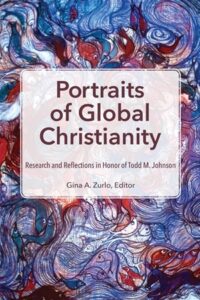 I re-posted Hoglund’s review of Global Christianity here. Following that review, on the same page, is a write-up about a related book edited by Gina Zurlo: Portraits of Global Christianity (William Carey Publishing, 2023):
I re-posted Hoglund’s review of Global Christianity here. Following that review, on the same page, is a write-up about a related book edited by Gina Zurlo: Portraits of Global Christianity (William Carey Publishing, 2023):
Most World Christianity books are written for scholarly audiences only. However, Portraits of Global Christianity moves beyond that sphere and into the lives of Christians who have learned about and continue to experience the global church in their everyday lives. No other global Christianity book on the market provides this kind of self-understanding on the relationship between World Christianity and individual experience.
This book is geared toward a general Christian audience and is written in an accessible style with attractive full-color charts, maps and graphs to make quantitative data on Christianity and other religions come alive.
Gina Zurlo gave an 11 minute YouTube presentation at the General Assembly of the World Council of Churches in Karlsruhe, Germany, September 2, 2022.
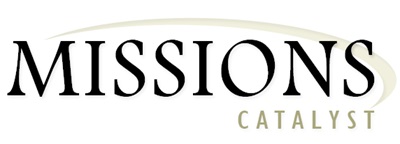 And if books won’t work, here is a valuable glimpse into World Christianity from the January 31 Missions Catalyst, “a free, weekly email digest designed to inspire and equip Christians worldwide for global ministry.”
And if books won’t work, here is a valuable glimpse into World Christianity from the January 31 Missions Catalyst, “a free, weekly email digest designed to inspire and equip Christians worldwide for global ministry.”
Need numbers? The Center for the Study of Global Christianity at Gordon-Conwell Theological Seminary has released its 2024 Status of Global Christianity Report. A related article in the International Bulletin of Missionary Research is a bit pricey for non-subscribers, but you can download the one-page summary (the chart with the numbers) for free.
 It’s a lot to process, so you might want to look for secondary sources citing this resource. See, for example, 8 Encouraging Trends in Global Christianity for 2024 (Lifeway Research). Also consider these tips from Lifeway: How to Use Statistics in Your Sermons.
It’s a lot to process, so you might want to look for secondary sources citing this resource. See, for example, 8 Encouraging Trends in Global Christianity for 2024 (Lifeway Research). Also consider these tips from Lifeway: How to Use Statistics in Your Sermons.
Of course, there are also some less-than-encouraging trends to be aware of. Voice of the Martyrs also has a new 2024 Global Prayer Guide focused on the persecuted church. Looks like everything is on the website or available in booklet form.
The 2024 World Watch List, an annual ranking of the 50 countries where Christians face the most extreme persecution, is now out. Watch and consider how you can share their video, Top 10 Countries Where Christians Face Extreme Persecution (Open Doors).
Marti Wade does a great job with Missions Catalyst. Go here to check it out and here to subscribe.
Part III next week.
